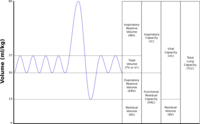
Photo from wikipedia
Background and Objective We aimed to assess the validity of using the Global Lung Function Initiative's (GLI) 2012 equations to interpret lung function data in a healthy workforce of South… Click to show full abstract
Background and Objective We aimed to assess the validity of using the Global Lung Function Initiative's (GLI) 2012 equations to interpret lung function data in a healthy workforce of South Australian Metropolitan Fire Service (SAMFS) personnel. Methods Spirometry data from 212 healthy, nonsmoking SAMFS firefighters were collected and predicted normal values were calculated using both the GLI and local population derived (Gore) equations for forced expiratory volume in one second (FEV1), forced vital capacity (FVC), and FEV1/FVC. Two-tailed paired sample Student's t-tests, Bland-Altman assessments of agreement, and z-scores were used to compare the two prediction methods. Results The equations showed good agreement for mean predicted FEV1, FVC, and FEV1/FVC. Mean z-scores were similar for FEV1 and FVC, although not FEV1/FVC, but greater than 0.5. Differences between the calculated lower limits of normal (LLN) were significant (p < 0.01), clinically meaningful, and resulted in an 8% difference in classification of abnormality using the FEV1/FVC ratio. Conclusions The GLI equations predicted similar lung function as population-specific equations and resulted in a lower incidence of obstruction in this sample of healthy SAMFS firefighters. Further, interpretation of spirometry data as abnormal should be based on both an FEV1 and FEV1/FVC ratio < LLN.
Journal Title: Canadian Respiratory Journal
Year Published: 2017
Link to full text (if available)
Share on Social Media: Sign Up to like & get
recommendations!